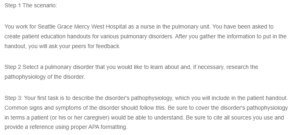Chronic Obstructive Pulmonary Disease (COPD)
Chronic Obstructive Pulmonary Disease (COPD) is the pulmonary disorder I have chosen to learn about and describe its pathophysiology. COPD refers to a chronic, progressive disease of the lungs where the patient finds it challenging to breathe. The airways’ narrowing and the lung tissue’s destruction characterize it (Hikichi et al., 2019). Smoking is a major contributor to COPD, but it may also be brought on by persistent air pollution exposure or occupational dust and chemicals.
The pathophysiology of COPD involves several key factors. First, the airways become inflamed, which leads to the production of mucus and the narrowing of the airways. This inflammation can also cause the lungs’ air sacs to become less elastic, making it more challenging for air to exhale. Over time, this can lead to a decrease in lung function and a reduction in the amount of oxygen delivered to the body (Hikichi et al., 2019). Hire our assignment writing services in case your assignment is devastating you.
The major COPD clinical presentation includes coughing, shortness of breath, wheezing, and chest tightness. These symptoms can worsen over time, making it difficult for the patient to perform daily activities such as walking or climbing stairs (Adeloye et al., 2022). Patients with COPD are also at increased risk for infections such as pneumonia and other complications such as heart disease and depression.
It is crucial for patients with COPD to receive regular medical care and to take steps to manage their symptoms. This may include quitting smoking, taking medications to reduce inflammation and open the airways, and participating in pulmonary rehabilitation programs to improve lung function and quality of life (Adeloye et al., 2022). Patients may also benefit from oxygen therapy, which can enhance the amount of oxygen in the blood and reduce the workload on the heart.
In summary, COPD is a chronic lung disease that causes lung tissue to be destroyed along with airway inflammation and constriction. Breathlessness, coughing, and pressure in the chest are typical symptoms. With proper medical care and management, patients with COPD can improve their lung function and quality of life.
References
Adeloye, D., Song, P., Zhu, Y., Campbell, H., Sheikh, A., & Rudan, I. (2022). Global, regional, and national prevalence of, and risk factors for, chronic obstructive pulmonary disease (COPD) in 2019: a systematic review and modeling analysis. The Lancet Respiratory Medicine, 10(5), 447-458. https://doi.org/10.1016/S2213-2600(21)00511-7
Hikichi, M., Mizumura, K., Maruoka, S., & Gon, Y. (2019). Pathogenesis of chronic obstructive pulmonary disease (COPD) induced by cigarette smoke. Journal of thoracic disease, 11(Suppl 17), S2129. https://doi.org/10.21037%2Fjtd.2019.10.43
ORDER A PLAGIARISM-FREE PAPER HERE
We’ll write everything from scratch
Question
Step 1 The scenario:
You work for Seattle Grace Mercy West Hospital as a nurse in the pulmonary unit. You have been asked to create patient education handouts for various pulmonary disorders. After you gather the information to put in the handout, you will ask your peers for feedback.

Chronic Obstructive Pulmonary Disease (COPD)
Step 2 Select a pulmonary disorder that you would like to learn about and, if necessary, research the pathophysiology of the disorder.
Step 3: Your first task is to describe the disorder’s pathophysiology, which you will include in the patient handout. Common signs and symptoms of the disorder should follow this. Be sure to cover the disorder’s pathophysiology in terms a patient (or his or her caregiver) would be able to understand. Be sure to cite all sources you use and provide a reference using proper APA formatting.

